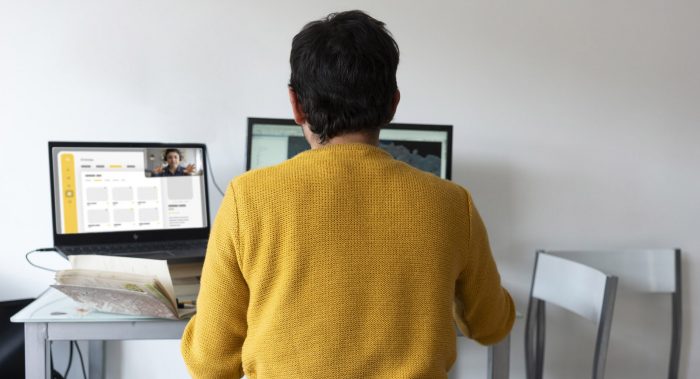Do you need remote usability testing?
Why might you need to employ remote usability testing? There are times when face-to-face user testing may not be possible or desirable. For example due to social distancing, having geographically spread users, employees who are time poor, or users that have difficulty travelling due to a disability. But you are still aware of the importance of involving real users in your design process so you can identify usability problems and optimise your user experience.
Remote usability testing is often the preferred option for gaining vital feedback from users in these scenarios.
What does remote testing involve?
Remote usability testing sessions follow a similar structure to a face-to-face testing session. The only real difference is that the researcher and participant are in different locations, so the session is conducted via video web conferencing tools (or less technical solutions should the user group not have access to this technology).
Using online meeting tools allows mutual screen-sharing. We are able to share design ideas for users to review, prototypes for users to test and websites to interact with. They can also share their screen to show us examples of competitor products they like or how they would normally go about a task.
Audio capability allows us to maintain a conversation with the participant, so they can explain what they’re doing and so we can ask them questions; just as we would if we were in the room with them. We can also pass on links and written materials via an integral chat feature, or email materials in advance. This might include an online research consent form or a list of questions or materials to look through before their session.
As well as one-to-one sessions, we can also run focus groups using online collaboration tools. With the right technology and experienced researchers these can provide valuable insights about user behaviour, user journeys, feedback on design ideas and users’ ideas for the future.
What are the benefits of remote testing?
Participants can be recruited from a wider geographical area; across the UK or globally.
- There are no travel costs for participants (meaning incentives are often slightly lower) or clients.
- Participants who may not be able to take part in research in a lab due to a disability can be included in the research.
- Participants who don’t have time to travel to a research venue can be more easily recruited.
- Social distancing (and changing rules around this) does not cause a problem to the planning or execution of the research.
- Users are in their natural environments using the their own technology that they would be using when interacting with your product in real life.
- Multiple observers can view the sessions simultaneously and live from a location of their choice.
 Talk to us about your requirements, budget and stage of design, and we will tailor our approach to meet your needs.
Talk to us about your requirements, budget and stage of design, and we will tailor our approach to meet your needs. Our toolkit of user testing techniques include:
- Task based approach
- Listening labs
- Eye tracking
- Card sorting (open and closed)
- Focus groups
- Pre-session probe kits
- Co-design
Examples of our work in this area
Our expert researchers have a wealth of experience conducting remote user research, testing prototypes, reviewing websites and gathering insights. They will tailor the research itself as well as how we present findings and insights back to you, according to how you will use them. So, whether you need a detailed user testing report, a lean PowerPoint, an infographic or a customer journey map, our researchers and designers will deliver exactly what’s needed.
Examples of remote research we have conducted include:
- Understanding how users from across the globe accrue and use airmiles.
- Exploring eating habits and behaviours amongst teenagers, and their reaction to a new discount app.
- Exploring new subtitle positioning within BBC iPlayer.
- Exploring use of new settings options for CBeebies, CBBC and Bitesize games, with a mix of children, with and without accessibility needs.
 For more information on how remote user testing can help your business, please contact us.
For more information on how remote user testing can help your business, please contact us.
 Participants can be recruited from a wider geographical area; across the UK or globally.
Participants can be recruited from a wider geographical area; across the UK or globally.